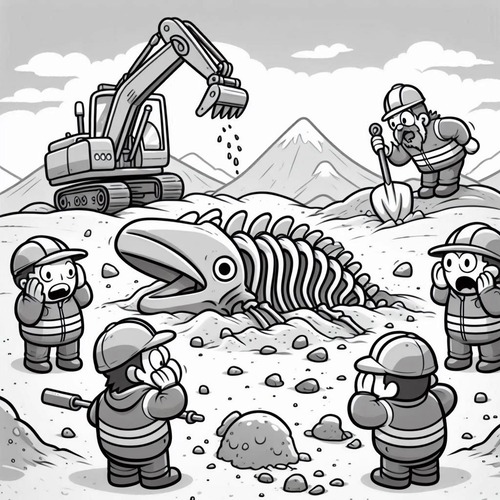Rocks Don’t Lie: 10 Global Evidences Supporting Noah’s Flood
The account of Noah’s Flood in Genesis is a cornerstone of Biblical history, describing God’s judgement on a sinful world and His mercy in preserving life. While many dismiss this event as myth, the geological record provides compelling evidence that aligns with the Biblical narrative.
Whale fossils found in Chile’s Atacama Desert in 2010: Why are these touted as evidences supporting Noah’s flood? In 2010, road construction workers in Chile’s Atacama Desert stumbled upon an extraordinary discovery: a massive graveyard of ancient marine mammals. This site, now known as Cerro Ballena (Whale Hill), yielded the fossilised remains of over 20 whales, along with other marine creatures, in what is now one of the driest places on Earth.
How did these ocean giants end up entombed in the desert, far from any current shoreline? While secular scientists propose a series of algal bloom events over millions of years, the global Flood model provides a more compelling explanation:
- Rapid Burial: The excellent preservation of these fossils suggests rapid burial, which aligns with the catastrophic nature of the global Flood.
- Marine Life in Deserts: The presence of marine fossils in a desert environment is precisely what we’d expect to find in the aftermath of a worldwide deluge that covered all land.
- Multiple Species: The site contains various whale species and other marine animals, indicating a mass death event rather than isolated incidents.
- Global Pattern: Similar discoveries have been made worldwide, including whale fossils in the Sahara Desert, Egypt, marine fossils high in the Andes Mountains, Peru, and whale fossils in Michigan, USA, far from any ocean.
These findings collectively point to a catastrophic, global event that rapidly buried marine life across continents—a scenario that fits perfectly with the Biblical account of Noah’s Flood. As we unearth more evidence like this, we continue to see how science aligns with Scripture, revealing the truth of God’s Word written in the very rocks beneath our feet.
Let’s explore ten other global evidences that support the reality of a worldwide, catastrophic flood as described in Scripture.
- Marine Fossils on Mountain Peaks: One of the most striking evidences for a global flood is the presence of marine fossils high above current sea levels. Fossilised sea creatures have been discovered in mountain ranges worldwide, including the Himalayas, Rockies, and Alps. These findings aren’t isolated—they’re extensive and widespread. For example, limestone beds containing marine fossils can be found atop the Andes Mountains at elevations exceeding 15,000 feet. This global distribution of marine fossils on high ground strongly suggests that ocean waters once covered the continents, just as described in Genesis 7:19-20.
- Rapid Burial of Flora and Fauna: The fossil record is replete with examples of plants and animals that appear to have been buried quickly and catastrophically. This is particularly evident in the preservation of soft-bodied organisms, which typically decay rapidly after death. The famous Burgess Shale in Canada, for instance, contains exquisitely preserved soft-bodied marine creatures that must have been buried almost instantly. Similarly, polystrate fossils—trees that extend through multiple rock layers—indicate rapid burial rather than slow accumulation of sediment. These observations align perfectly with the Biblical account of a sudden, catastrophic flood that would have rapidly entombed countless organisms in sediment.
- Long-Distance Sediment Transport: Geological formations around the world reveal sedimentary layers containing materials transported from distant locations. For example, the Morrison Formation, which spreads across western North America, contains sediments that originated from as far away as Appalachia—over 1,000 miles to the east. This long-distance transport of enormous quantities of sediment is consistent with the powerful water currents that would have been generated during a global flood, as described in Genesis 7:11 when “all the fountains of the great deep burst forth.”
- Vast, Rapidly Deposited Sediment Layers: Sedimentary rock layers often extend across vast areas, showing remarkable consistency in composition and thickness. The Tapeats Sandstone, for instance, stretches from the Grand Canyon across much of North America and even into Canada. Such widespread, uniform layers are difficult to explain by slow, gradual processes but are exactly what we would expect from the massive sediment deposition during a global flood. The lack of erosion between many of these layers further supports their rapid, successive deposition, aligning with the year-long flood described in Genesis.
- Absence of Erosion Between Strata: In many geological formations, we observe multiple layers of sedimentary rock stacked atop one another with little to no evidence of erosion between them. If these layers were deposited over millions of years, we would expect to see significant weathering and erosion at their boundaries. Instead, the smooth, knife-edge transitions between many layers suggest they were laid down in rapid succession, consistent with the continuous deposition of sediment during Noah’s Flood.
- Rapidly Deposited Strata: Numerous locations worldwide exhibit multiple layers of sedimentary rock that appear to have been deposited without significant time gaps. The walls of the Grand Canyon, for example, display a sequence of flat-lying strata with no evidence of long time periods between their formations. This pattern of rapid, successive deposition aligns well with the Biblical account of a year-long global flood that would have laid down multiple sediment layers in quick succession.
- Extensive Flat Plateaus: The existence of vast, flat plateaus across the globe presents another piece of evidence for a catastrophic flood. These remarkably level surfaces, such as the Colorado Plateau in the United States or the Deccan Plateau in India, show little sign of the erosion we would expect over millions of years. Their widespread distribution and flatness are better explained by the rapid deposition of sediments settling out from flood waters, as would occur during a global deluge.
- Megasequences and Canyons: Massive canyons and valleys, exemplified by the Grand Canyon, bear testimony to catastrophic carving by large volumes of water. While uniformitarian geology suggests these formed slowly over millions of years, the Biblical Flood model provides a more satisfactory explanation. The receding waters of Noah’s Flood, as described in Genesis 8:3, would have carved such features rapidly as immense volumes of water drained off the continents.
- Global Distribution of Water Gaps: Water gaps, where rivers cut through mountain ranges, are found on every continent. These features often defy conventional explanations, as rivers appear to flow through mountains rather than around them. The global prevalence of water gaps aligns with the Flood model, where receding floodwaters would have carved paths through newly uplifted mountains, establishing drainage patterns we see today.
- Widespread Underfit Streams: Many river valleys around the world are occupied by streams that seem too small to have carved their surrounding valleys. These “underfit” streams suggest that much larger volumes of water once flowed through these channels. This global phenomenon fits perfectly with the Biblical Flood model, where the current rivers are mere remnants of the massive water flows that drained the continents as the Flood waters receded.
Evidences Supporting Noah’s Flood—Conclusion: When we examine the geological evidence through the lens of Scripture, we find remarkable support for the global Flood described in Genesis. From marine fossils on mountaintops to vast sediment layers and rapidly carved canyons, the physical evidence aligns closely with what we would expect from a worldwide, catastrophic flood. For Christians, this scientific evidence strengthens our faith in the inerrancy of Scripture and the historical reality of Noah’s Flood. It reminds us of God’s judgement against sin, His mercy in preserving life, and His faithfulness to His promises—lessons that remain profoundly relevant for us today.
Evidences Supporting Noah’s Flood—Related FAQS:
- How do fossils of sea creatures end up on mountains? Marine fossils found on mountain peaks suggest that these areas were once submerged under water. A global flood, as described in the Bible, could have caused ocean waters to rise dramatically, covering even the highest elevations.
- Why is the rapid burial of plants and animals significant? The rapid burial of organisms is crucial for fossilisation, which requires quick coverage by sediment to prevent decay. This kind of sudden, widespread burial is consistent with the catastrophic conditions of a global flood.
- What does the widespread distribution of sedimentary layers tell us? Sedimentary layers spread across vast regions indicate that a massive, continent-wide event deposited them. A global flood would have created the powerful currents needed to transport and lay down such extensive layers quickly.
- Why is the lack of erosion between sedimentary layers important? The absence of significant erosion between layers suggests that they were deposited in rapid succession, without long periods between events. This supports the idea of a rapid, large-scale flood rather than slow geological processes.
- How do plateaus provide evidence for a global flood? Many plateaus are remarkably flat and show little erosion, which implies they were formed quickly by a large-scale event. The global extent of these flat, high-elevation areas points to a flood that covered entire continents.
- What do mega valleys and canyons reveal about Earth’s history? Mega valleys and canyons, such as the Grand Canyon, appear to have been carved by massive volumes of water over a short time. This aligns with the idea of a global flood that reshaped the Earth’s surface dramatically.
- Why are underfit rivers significant in flood geology? Underfit rivers, which are too small to have carved the valleys they flow through, suggest that much larger water flows once shaped these landscapes. This evidence supports the occurrence of a massive, global flood.
Evidences Supporting Noah’s Flood—Related Reads:
Editor's Pick

Why Do People Hate the Doctrine of Election?
…WHEN THEY REALLY SHOULDN’T Few Bible doctrines provoke stronger reactions than election. The idea that God chose some for salvation [...]

The Doctrine of Providence: Does God Really Govern All Things?
You’re sitting in the doctor’s office when the diagnosis lands like a thunderclap. Your mind races: Why this? Why now? [...]

No Decay, No Defeat: What It Means That Christ’s Body Saw No Corruption
On the Day of Pentecost, Peter stood before thousands and made a startling claim: David's body decayed in the tomb, [...]
SUPPORT US:
Feel the Holy Spirit's gentle nudge to partner with us?
Donate Online:
Account Name: TRUTHS TO DIE FOR FOUNDATION
Account Number: 10243565459
Bank IFSC: IDFB0043391
Bank Name: IDFC FIRST BANK






